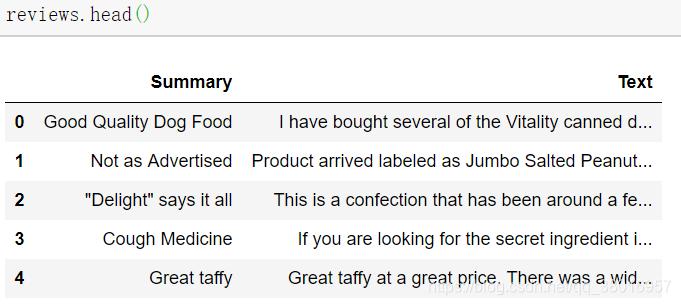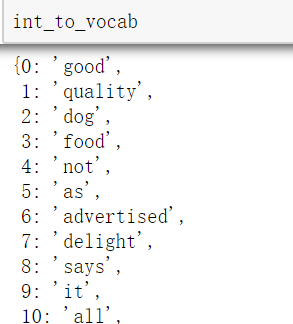Summarizing Text with Amazon Reviews
数据集:Amazon 500000评论
本节内容:
- 数据预处理
- 构建Seq2Seq模型
- 训练网络
- 测试效果
seq2seq教程: https://github.com/j-min/tf_tutorial_plus/tree/master/RNN_seq2seq/contrib_seq2seq
https://www.jianshu.com/p/c0c5f1bdbb88
浏览数据集

将少量的含有缺失值的记录和其他属性dropout

1、数据预处理
- 全部转换成小写
- 连词转换
- 去停用词(只在描述中去掉)
- 去除特殊字符
https?:\/\/.*[\r\n]*\<a href[_"\-;%()|+&=*%.,!?:#$@\[\]/]
re.sub(r'https?:\/\/.*[\r\n]*\<a href[_"\-;%()|+&=*%.,!?:#$@\[\]/]`', ' ', text)
- 连词转换:
“can’t’ve”: “cannot have”,
“'cause”: “because”,
“could’ve”: “could have”,
# 统计不重复的词的个数
def count_words(count_dict, text):'''Count the number of occurrences of each word in a set of text'''for sentence in text:for word in sentence.split():if word not in count_dict:count_dict[word] = 1else:count_dict[word] += 1# Find the number of times each word was used and the size of the vocabulary
word_counts = {
}count_words(word_counts, clean_summaries)
print("Size of Vocabulary:", len(word_counts))
count_words(word_counts, clean_texts)
print("Size of Vocabulary:", len(word_counts))
OUT:
Size of Vocabulary: 33809
Size of Vocabulary: 132884
我们的任务通过seq2seq完成encode-decod的操作,需要词向量作为输入,这里的词向量也可以用别人训练好的词向量喂入模型。github上有训练好的词向量
格式:[0]为单词 ,[1:]为向量
/c/en/absolute_value -0.0847 -0.1316 -0.0800 -0.0708 -0.2514 -0.1687 -…
现将单词和其向量转换为字典的格式
embeddings_index = {
}
with open('numberbatch-en-17.04b.txt', encoding='utf-8') as f:for line in f:values = line.split(' ')word = values[0]embedding = np.asarray(values[1:], dtype='float32')embeddings_index[word] = embedding
词库中的词不一样全都在词向量文件中,所以需要统计词库不在词向量文件中的单词,如果是词频大于20,且词向量文件中没有,就直接建立一个相同维度的向量训练即可。
统计miss单词的占比:
Number of words missing from CN: 3866
Percent of words that are missing from vocabulary: 2.91%
现将词频大于20的构建数字和单词的映射,方便计算机理解。
将标识符也加入词汇中,开始、PAD、unknow和结束符号
codes = ["<UNK>","<PAD>","<EOS>","<GO>"]
int_to_vocab:

vocab_to_int:

做好词语和数字的映射之后,再将每一个语句中的单词转换为数字形式:有些词如词频小于20、还没有过滤掉的则替换为’unknown’
def convert_to_ints(text, word_count, unk_count, eos=False):'''Convert words in text to an integer.If word is not in vocab_to_int, use UNK's integer. ’unknown‘Total the number of words and UNKs.Add EOS token to the end of texts'''ints = []for sentence in text:sentence_ints = []for word in sentence.split():word_count += 1if word in vocab_to_int:sentence_ints.append(vocab_to_int[word])else:sentence_ints.append(vocab_to_int["<UNK>"])unk_count += 1if eos:sentence_ints.append(vocab_to_int["<EOS>"])ints.append(sentence_ints)return ints, word_count, unk_count
得到数字表示的句子:

为了更能清晰的观察数据,将每个句子的长度转换DataFrame,再用describe函数查看具体情况

查看%90、95、99分位的数值

现在再对句子进行一次过滤,
- 1、对summaries和text过滤:
一句话中unk太多,设定阈值过滤一些句子 - 2、对summaries和text的长度排序,只取%90分位以下的长度值即可
sorted_summaries = []
sorted_texts = []
max_text_length = 84
max_summary_length = 13
min_length = 2
unk_text_limit = 1
unk_summary_limit = 0for length in range(min(lengths_texts.counts), max_text_length): for count, words in enumerate(int_summaries):if (len(int_summaries[count]) >= min_length andlen(int_summaries[count]) <= max_summary_length andlen(int_texts[count]) >= min_length andunk_counter(int_summaries[count]) <= unk_summary_limit andunk_counter(int_texts[count]) <= unk_text_limit andlength == len(int_texts[count])):sorted_summaries.append(int_summaries[count])
到这里,就完成了对数据的筛选,处理部分,接下来构造Seq2Seq模型
2、构造Seq2Seq模型
Bidirectional RNNs(双向网络)的改进之处便是,假设当前的输出(第t步的输出)不仅仅与前面的序列有关,并且还与后面的序列有关。
例如:预测一个语句中缺失的词语那么就需要根据上下文来进行预测。Bidirectional RNNs是一个相对较简单的RNNs,是由两个RNNs上下叠加在一起组成的。输出由这两个RNNs的隐藏层的状态决定的
- 输入xt乘以权值W+记忆乘以权重V+b

(1)数据输入
将数据切分,在每个句子前加‘’标识符
def process_encoding_input(target_data, vocab_to_int, batch_size):'''Remove the last word id from each batch and concat the <GO> to the begining of each batch'''ending = tf.strided_slice(target_data, [0, 0], [batch_size, -1], [1, 1])dec_input = tf.concat([tf.fill([batch_size, 1], vocab_to_int['<GO>']), ending], 1)return dec_input
strded_slicc(起始,结束,步长),举例:


(2)encoding_layer
动态双向RNN,输出enc_output, enc_state
def encoding_layer(rnn_size, sequence_length, num_layers, rnn_inputs, keep_prob):'''Create the encoding layer'''for layer in range(num_layers):with tf.variable_scope('encoder_{}'.format(layer)):cell_fw = tf.contrib.rnn.LSTMCell(rnn_size,initializer=tf.random_uniform_initializer(-0.1, 0.1, seed=2))cell_fw = tf.contrib.rnn.DropoutWrapper(cell_fw, input_keep_prob = keep_prob)cell_bw = tf.contrib.rnn.LSTMCell(rnn_size,initializer=tf.random_uniform_initializer(-0.1, 0.1, seed=2))cell_bw = tf.contrib.rnn.DropoutWrapper(cell_bw, input_keep_prob = keep_prob)enc_output, enc_state = tf.nn.bidirectional_dynamic_rnn(cell_fw, cell_bw, rnn_inputs,sequence_length,# 一个batchSize的大小dtype=tf.float32)# Join outputs since we are using a bidirectional RNN enc_output = tf.concat(enc_output,2)return enc_output, enc_state(3)训练,辅助层
1、训练:training_decoding_layer:
tf.contrib.seq2seq. TrainingHelperBasicDecoderdynamic_decode2、测试:inference_decoding_layer
tf.contrib.seq2seq.GreedyEmbeddingHelperBasicDecoderdynamic_decode
(4)decoding_layer
LSTMCell
BahdanauAttention
AttentionWrapperwith tf.variable_scope("decode"):training_logits = training_decoding_layer(dec_embed_input, summary_length, dec_cell, initial_state,output_layer,vocab_size, max_summary_length)with tf.variable_scope("decode", reuse=True):inference_logits = inference_decoding_layer(embeddings, vocab_to_int['<GO>'], vocab_to_int['<EOS>'],dec_cell, initial_state, output_layer,max_summary_length,batch_size)
(5)seq2seq_model
将上面建立的操作结合
(6)Graph built
get_batches 得到batch
pad_sentence_batch 将长度不够的句子用’PAD‘补齐
tf.contrib.seq2seq.sequence_loss
tf.train.AdamOptimizer